

Accurate Prediction of Worst Case Eye Diagrams for Non-Linear Signaling Systems Aadithya V. Karthik*, Sayak Ray, Robert Brayton, and Jaijeet Roychowdhury EECS Dept., The University of California, Berkeley Mar 2014, TAU, Santa Cruz Aadithya V. Karthik ( aadithya@berkeley.edu) Mar 2014, TAU, Santa Cruz 1/17
Overview of this talk • The Worst Case (WC) eye diagram problem – Starting from the basics, i.e., what is an eye diagram? • Existing algorithms for WC eye estimation – PDA, illustrated with an example • Where PDA fails – Cannot handle general formulations of problem • A new algorithm for WC eye computation – Illustrated with an example • Results – 8b/10b encoder (PCI Express, USB, etc.) – Our technique is much less pessimistic than PDA Aadithya V. Karthik ( aadithya@berkeley.edu) Mar 2014, TAU, Santa Cruz 2/17
What is an Eye Diagram (1/2)? Bits Analogish “Bits” Analog Channel (delay, ISI, crosstalk, etc.) Aadithya V. Karthik ( aadithya@berkeley.edu) Mar 2014, TAU, Santa Cruz 3/17
What is an Eye Diagram (2/2)? Eye Overlay sections between dashed vertical lines WC Eye Eye Aadithya V. Karthik ( aadithya@berkeley.edu) Mar 2014, TAU, Santa Cruz 4/17
The Worst Case Eye Problem Correlated Arbitrary Bit sequence Analog (LTI) Digital System Channel Output eye PDA • Pure analog → PDA • Analog + Digital – Non-Linear System – Correlated bits – PDA too pessimistic Problem: Compute – Our new algorithm! worst-case eye Aadithya V. Karthik ( aadithya@berkeley.edu) Mar 2014, TAU, Santa Cruz 5/17
Peak Distortion Analysis (PDA) • Assume channel is LTI • Key idea: WC Eye = 2 Optimization Problems LTI Channel WC1 WC0 Linear combination of the bits! Need mutually independent bits [0, 1, 0, 1, 1] Correlated bits: PDA fails! Aadithya V. Karthik ( aadithya@berkeley.edu) Mar 2014, TAU, Santa Cruz 6/17
FSMs for Modeling Correlated Bits Correlated Bit sequence Analog (LTI) FSM Digital System Channel Arbitrary digital logic, arbitrary bit correlations • Finite number of states For example, this FSM • Arcs denoting state transitions can never produce the sequence [0, 1, 1] – Each arc has an output bit Aadithya V. Karthik ( aadithya@berkeley.edu) Mar 2014, TAU, Santa Cruz 7/17
Algorithm for Correlated WC Eye Key idea: Best partial sum ending in state Si Aadithya V. Karthik ( aadithya@berkeley.edu) Mar 2014, TAU, Santa Cruz 8/17
Algorithm for Correlated WC Eye Key idea: Best partial sum ending in state Si Aadithya V. Karthik ( aadithya@berkeley.edu) Mar 2014, TAU, Santa Cruz 9/17
Algorithm for Correlated WC Eye Key idea: Best partial sum ending in state Si Aadithya V. Karthik ( aadithya@berkeley.edu) Mar 2014, TAU, Santa Cruz 10/17
Algorithm for Correlated WC Eye Key idea: Best partial sum ending in state Si Aadithya V. Karthik ( aadithya@berkeley.edu) Mar 2014, TAU, Santa Cruz 11/17
Algorithm for Correlated WC Eye Key idea: Best partial sum ending in state Si Aadithya V. Karthik ( aadithya@berkeley.edu) Mar 2014, TAU, Santa Cruz 12/17
Algorithm for Correlated WC Eye Key idea: Best partial sum ending in state Si Compare to PDA, which pessimistically predicts 0.5 Dynamic programming Aadithya V. Karthik ( aadithya@berkeley.edu) Mar 2014, TAU, Santa Cruz 13/17
Results: 8b/10b Encoder (1/2) • 8b/10b Encoder + LTI Channel 8b parallel 8b/10b Encoder 10b serial LTI Channel Aadithya V. Karthik ( aadithya@berkeley.edu) Mar 2014, TAU, Santa Cruz 14/17
Results: 8b/10b Encoder (2/2) • 8b/10b Encoder + LTI Channel Ours PDA Aadithya V. Karthik ( aadithya@berkeley.edu) Mar 2014, TAU, Santa Cruz 15/17
Summary • WC eye computation is important • Traditional PDA cannot handle bit correlations • Our new technique can • Key ideas behind our technique – Model bit correlations as FSMs – Reduce WC eye computation to an optimization problem – Use dynamic programming to solve the above efficiently • Results – (7, 4) Hamming code – 8b/10b Encoder • Future work – Deterministic worst case → Probabilistic distributions Aadithya V. Karthik ( aadithya@berkeley.edu) Mar 2014, TAU, Santa Cruz 16/17
Questions Aadithya V. Karthik ( aadithya@berkeley.edu) Mar 2014, TAU, Santa Cruz 17/17
Recommend
More recommend